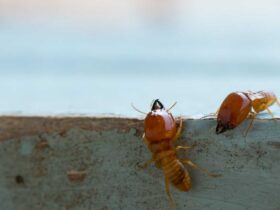Bed bugs are notorious pests that can turn a peaceful night’s sleep into a nightmare. These small, elusive insects thrive in warm environments, making homes, hotels, and even public transport ideal breeding grounds. As bed bug infestations become increasingly common, understanding effective bed bug control methods is crucial for homeowners and renters alike. This article explores various strategies for managing and eliminating bed bugs, ensuring a restful environment free from these unwanted guests.
Understanding Bed Bugs: Biology and Behavior
Bed bugs, scientifically known as Cimex lectularius, are small, reddish-brown insects that feed on the blood of humans and other warm-blooded animals. Adult bed bugs are about the size of an apple seed, while their nymphs are much smaller. They are primarily nocturnal, preferring to come out at night when their hosts are asleep. Their flat bodies allow them to hide in the tiniest of crevices, such as mattress seams, bed frames, and even electrical outlets.
Recognizing the signs of a bed bug infestation is essential for effective control. Common indicators include bite marks on the skin, small blood stains on sheets, and dark fecal spots on bedding or furniture. Understanding their biology and behavior is key to developing a comprehensive bed bug control plan.
Early Detection: The First Step in Bed Bug Control
Early detection is critical in any effective bed bug control strategy. If you suspect a bed bug infestation, take immediate action to confirm the presence of these pests. Begin by conducting a thorough inspection of your living space. Check common hiding spots such as mattresses, box springs, bed frames, and upholstered furniture. Pay close attention to seams, folds, and crevices, as these are preferred harborage areas for bed bugs.
If you find evidence of bed bugs, it’s essential to act quickly. Delaying treatment can lead to a more extensive infestation that is harder to control. Using a flashlight during your inspection can help you identify the pests and their droppings more easily. In addition to physical inspections, consider using bed bug detection tools, such as interceptors or bed bug monitors, to trap any bugs that may be lurking.
Professional Bed Bug Control: When to Call the Experts
While there are several DIY methods for controlling bed bugs, severe infestations often require professional intervention. Pest control experts possess the knowledge, experience, and equipment needed to effectively eradicate these pests. When selecting a pest control company, look for one with a proven track record in bed bug control.
A typical professional treatment may involve several steps. The pest control technician will first conduct a comprehensive inspection of your home to identify the extent of the infestation. Once the assessment is complete, they will recommend a suitable treatment plan. This may include chemical treatments, heat treatments, or a combination of both.
Chemical treatments typically involve applying insecticides specifically formulated to target bed bugs. These products are designed to eliminate both adult bed bugs and their eggs. On the other hand, heat treatments involve raising the temperature of your living space to a level lethal to bed bugs. This method is particularly effective because it can reach bugs hidden in crevices that insecticides might miss.
No matter the method, professional bed bug control ensures that the infestation is handled efficiently and safely, minimizing the risk of re-infestation.
DIY Bed Bug Control: Home Remedies and Prevention Tips
For minor infestations or as a supplementary measure to professional treatments, several DIY bed bug control methods can be employed. However, it’s important to note that these methods may not be as effective as professional services and are best used in conjunction with them.
One effective DIY approach is thorough cleaning. Start by washing all bedding, linens, and clothing in hot water. High temperatures can kill bed bugs at all life stages. After washing, place these items in a hot dryer for at least 30 minutes. Vacuuming your home is another essential step. Use a vacuum with a hose attachment to target areas where bed bugs are likely to hide, including baseboards, carpets, and furniture. Be sure to dispose of the vacuum bag immediately in a sealed plastic bag to prevent any potential re-infestation.
Sealing cracks and crevices in walls, floors, and furniture is also crucial in bed bug control. Use caulk to seal these openings, as bed bugs can easily slip through small gaps. Additionally, consider encasing your mattresses and box springs in bed bug-proof covers. These covers create a barrier that prevents bed bugs from entering or escaping, making it easier to eliminate them.
Another preventive measure is to be cautious when traveling. Bed bugs are notorious for hitching rides in luggage and clothing. When staying in hotels, inspect the room for signs of bed bugs before unpacking. Use luggage racks to keep your bags off the floor and away from potential infestations.
Ongoing Monitoring and Maintenance for Bed Bug Control
After addressing a bed bug infestation, ongoing monitoring is essential to ensure that these pests do not return. Regularly check your living space for signs of bed bugs, especially after traveling or hosting guests. If you detect any signs of bed bugs, take immediate action to prevent a full-blown infestation.
Consider using bed bug monitors or interceptors placed under the legs of your bed or furniture. These devices can trap bed bugs as they attempt to climb up, providing an early warning system. Regular inspections and monitoring will help you maintain a bed bug-free environment.
In addition to monitoring, maintaining cleanliness in your home can significantly reduce the likelihood of a bed bug re-infestation. Keep clutter to a minimum, as bed bugs thrive in chaotic environments. Regular vacuuming and cleaning can help disrupt their hiding spots and prevent future infestations.
Ultimately, effective bed bug control requires a combination of vigilance, preventive measures, and prompt action at the first sign of these pests. By understanding bed bugs’ behavior and lifecycle, employing professional services when necessary, and practicing ongoing monitoring, you can create a comfortable and safe living environment free from bed bugs.
Incorporating these strategies into your routine will not only help you manage existing infestations but also prevent future ones, ensuring your home remains a sanctuary of rest and relaxation. With diligence and proactive measures, it is entirely possible to reclaim your space from these persistent pests, allowing you to sleep soundly once more.












